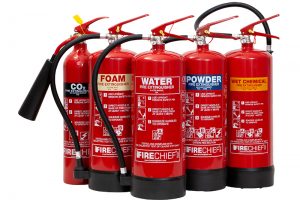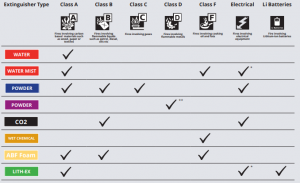Recently added item(s)
You have no items in your basket.

Whilst fire extinguishers may all look the same to the casual observer, there are a vast assortment of extinguisher types, all suited to tackling different types of fire. Even similar types of extinguisher can have different applications. In this article we look at the various types and their relative strengths and weaknesses.
First let’s review the different fire classes, which are determined by the type of fuel involved:
Flammable solids such as wood, paper, textiles, i.e., solids containing carbon. Also, some plastics fall into this category.
Flammable liquids and liquifiable solids such as petrol, mineral oil, paint, and solvents. They can be further subdivided into two groups:
Certain plastics and waxes that are normally solid may become free flowing when on fire and would also be a Class B material as opposed to Class A.
The selection of extinguishers can also depend on if the fuel is contained, spilt, flowing/running or three dimensional (affected by obstructions).
Flammable gases or liquefiable gases, such as Methane, Propane, Butane, Acetylene, etc.
This class presents an extreme hazard if extinguished other than by isolating the supply and should only be tackled by specialist personnel.
Where the gas supply has been isolated as part of firefighting operations any remaining fire will not be a Class C fire and the appropriate agent for the nature of the remaining fire should be used (likely to be Class A, B or F).
Flammable reactive metals such as Sodium, Lithium, Magnesium, Uranium, etc.
Fires in cooking media (vegetable or animal oils and fats) in cooking appliances.
The great heat related to fires involving cooking oils (where the temperature of the burning liquid is @ 350C as opposed to 50C for petrol) means that they are harder to extinguish and many agents that are effective on other liquid fires are useless on these, hence the separate classification.
Electrical equipment: This is not a separate class of fire as any material ignited by electrical equipment will fall into Classes A, B, C, D or F. However, the term is used to describe any fire complicated by the presence of electricity, such as televisions, transformers, switchgear, etc.
Non-conductive media should be used.
Not currently a separate class, Lithium-ion batteries are technically Class A fires with an electrical hazard. However, a fire of this type is created by a chemical reaction (and not as per the conventional understanding of the fire triangle of Oxygen, Heat and Fuel), due to the unique properties of Lithium-Ion batteries. The thermal runaway reaction and resulting fire make them difficult to control and mean these fires need special consideration as many normally suitable extinguishers will fail to extinguish.
Water is the oldest and most widely used extinguishing agent and uses cooling to extinguish fire. Water extinguishers fall into three types:
The 9-litre water jet extinguisher is still seen in use but is somewhat obsolescent due to its heavy weight and limited uses. Whilst effective on Class A fires, it offers no operator protection around electrical equipment and is dangerous on all other types of fire and only remains an option where a longer discharge range is needed.
This extinguisher is suited to Class A fires but has the advantage of using smaller and lighter extinguishers whilst retaining the same firefighting power as larger water jet extinguishers. Many are available with an additive (either detergent or chemical salts based) that breaks the surface tension of the water making it ‘wetter’ and able to soak more readily into burning material such that a 3-litre water additive extinguisher can match a 9-litre water jet extinguisher. The spray nozzle gives operator protection against use around electrical equipment as the discharge is non-conductive up to 35kV, however the extinguisher remains suitable only for Class A fires.
This extinguisher has a special nozzle that discharges fine droplets of water that absorb large amounts of heat and turn into steam around the fuel. As the water doesn’t mix with the fuel it has a wider application than other water extinguishers so in addition to Class A fires these extinguishers are rated for Class F fires and directly on electrical equipment fires up to 1000V. They are safe on Class B fires but can only tackle small liquid fires such that they shouldn’t be provided specifically for this risk.
Foam extinguishers contain water mixed with a foam concentrate which forms a film or blanket that floats on the surface of burning liquids cutting off the oxygen supply and smothering the fire. This makes it ideal for Class B fires, particularly those in containers. Foam is unique in that it can be used to prevent a fire – if you spill a flammable liquid covering it in foam will trap flammable vapours and seal off oxygen, preventing re-ignition.
The cooling effect of the water means they are also excellent on Class A fires as well. The spray nozzle gives operator protection against use around electrical equipment as the discharge is non-conductive up to 35kV.
Where Polar Solvents such as alcohols are involved, normal foam extinguishers are of limited use as the foam blanket is destroyed by the solvent and specialist Alcohol Resistant foams are required that also contain a polymer that protects the foam blanket from decay.
Standard Foam is unsuitable for Class F fires as the extreme temperature of the cooking oil destroys the foam blanket, although some special foam extinguishers are marked for Class F fires as they contain a phosphoric acid salt additive that boosts the heat resistance of the foam blanket
There is heightened concern about fire-fighting foams that contain or may contain Perfluorooctanesulfonic acid (PFOS) or Perfluorooctanoic acid (PFOA). These fluorine chemicals are associated with C8 technology and are extremely stable and remain mobile in the environment for many decades.
PFOS was banned in Europe in 2009 and PFOA in 2020 and the vast majority of foam manufacturers based in Europe have not used these types of fluorosurfactants for some years. All film forming foams manufactured in Europe for the EU/UK market are manufactured using fluorosurfactants based on C6 technology.
Wet Chemical extinguishers contain water mixed with potassium salts discharged as a spray or mist specifically for Class F fires. The solution saponifies the cooking oil turning it into a soapy scum that quickly dries out and crusts to form a smothering barrier over the remaining oil. The water content also cools the oil.
Whilst intended for Class F fires the water-based nature of the chemical means it has good Class A capability as well. The spray/mist nozzle gives operator protection against use around electrical equipment as the discharge is non-conductive up to 35kV.
These extinguishers use finely divided particles of various powdered chemicals and come in varying types:
The most common type, these use acidic ammonium phosphate-based powder that extinguishes fire by chemical inhibition, interrupting the chain reaction of fire, and on Class A fires it also melts to form a sticky coating over burning embers. Effective on Class A, B & C fires, the powder is also non-conductive for direct use on electrical equipment.
Less common, this uses alkaline powders such as Sodium or Potassium Bicarbonate and has similar capabilities as ABC Powder other than it should not be used for Class A fires as it does not melt and coat the embers and the fire, even if briefly knocked down, will restart.
Both these powders are ideal for rapid knockdown of Class B fires, especially those involving running or spill fires and both are safe for direct use on electrical equipment.
They suffer from a lack of cooling or physical blanketing effect meaning that they are unsuitable for Class F fires as the fire reflashes as soon as the powder is spent – this issue also means care needs to be taken against re-ignition on other Classes as well.
Powder can impair vision and affect breathing as well as cause considerable secondary damage so should be avoided where it could be used indoors when escape routes, vulnerable people or valuable items could be affected.
Special powders based on either Sodium Chloride, Graphite or Copper, these are intended for Class D fires only and smother the fire by being applied to cover the metal completely via a low velocity applicator and then melting and flowing to encapsulate the metal, shutting off oxygen and allowing gradual cooling. Different metals require different Class D powders, so specialist advice is always required – e.g., Sodium Chloride powders are unsuitable for Lithium metal. Some are very conductive so shouldn’t be used near electrical equipment.
CO2 gas has been used in extinguishers since the late 1920’s and extinguishes by displacing oxygen, with the added advantage of leaving no mess. It is primarily specified for direct use on electrical equipment where the ability to ‘creep’ through equipment enclosures to smother the fire gives it an advantage over other non-conductive agents, as does its non-damaging nature.
It also has the capability to extinguish small indoor Class B fires, meaning it is often the agent of choice for laboratories and similar environments.
The lack of cooling means it isn’t effective on Class A fires and the pressure of discharge could scatter burning solids as well. The lack of cooling and physical blanketing makes it unsuitable for Class F fires.
Rarely seen in portable extinguishers since the demise of halon extinguishers, vaporising liquids such as FE-36 & Novec liquid are still available in extinguishers either to protect delicate electronics or as a Halon replacement in motor sport, aircraft, and Police Public Order situations. They inhibit combustion in a similar manner to halon and generally have similar capability against Class B Fires, directly on electrical equipment and for larger units, small Class A fires.
The extinguishers are not suitable for Class F fires and should be avoided in very confined spaces.
AVD is an aqueous dispersion of chemically exfoliated vermiculite. It is applied to lithium-ion battery fires as a mist, which smothers and extinguishes them, preventing the propagation of the fire.
Vermiculite is the name given to a group of hydrated laminar aluminium-iron-magnesium silicates. It consists of thin, flat flakes containing microscopic layers of water. The chemical exfoliation of vermiculite produces microscopic, individual platelets that are freely suspended in water. This yields a stable aqueous dispersion of vermiculite to be used as a lithium-ion battery fire extinguishing agent.
The vermiculite particles within the mist are deposited on the surface of the burning fuel to create a film over the top of the fire. The film instantly dries and, because the high aspect ratio platelet particles overlap and bind together, a non-flammable oxygen barrier between the fuel and the atmosphere is produced.
This process has a cooling effect on the fuel source and, as the water content in AVD is evaporated, the vermiculite platelets begin to build up and the fire is brought under control.
AVD extinguishers are intended specifically for fires in equipment involving electrical equipment powered by Li-on batteries, although being water based do have a Class A capability to extinguish the surrounding casing and affected items.

Fire Depot has been the UK's favourite fire safety supplier for over 50 years, we know the fire protection and prevention business inside out. Our experienced team can offer advice and guidance about any of our fire safety products. For expert help and advice, please contact the Fire Depot team on 0330 999 2233, email us at sales@firedepot.co.ukor visit https://www.firedepot.co.uk/ to see our full range of fire safety products.
The information contained within this blog is provided solely for general informational and educational purposes and is not intended as a substitute for professional advice. Before taking any actions based upon this information, we advise the reader to consult any and all relevant statutory or regulatory guidance and where felt necessary to consult a qualified fire or industry regulation professional. The use or reliance on any information contained herein is solely at the reader’s risk.